I recently got a M4 Max Macbook Pro with 128 GB of DRAM. It has seemed to be a peppy machine. Today I benchmarked it against my main workstation, using the Puget Systems Photoshop benchmarking tool.
Spoiler: it’s pretty darned fast.
This isn’t really a fair fight. On one hand, the Dell 64-core 512GB Ryzen workstation is optimized for workloads with large memory footprints and lots of parallelism, like the Matlab programs that I run on it. Its scalar processing speed is modest. On the other hand, the Dell workstation consumes far more power than the Macbook, takes up a lot more room, and functions as a space heater in the winter.
Here’s the Mac, with a Logitech keyboard and the 27 inch Apple Studio display, a 5K monitor with excellent speakers and video camera.
Here’s the Dell workstation, with my Eizo 27 inch monitor:
Here are the Puget benchmark results for Photoshop 26.2 on the Mac.
And with the same version on the workstation.
The Mac is more than twice as fast.
Here are some more system specs:
The current beta version of Ps is about the same speed as 26.2 on the Dell workstation.
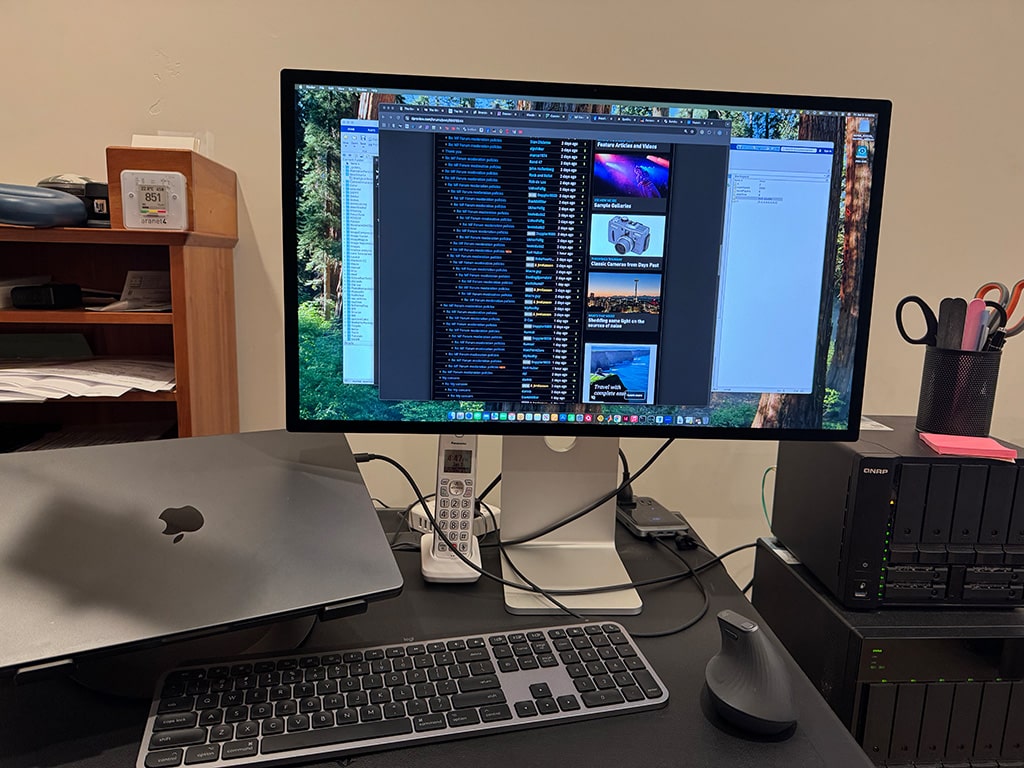
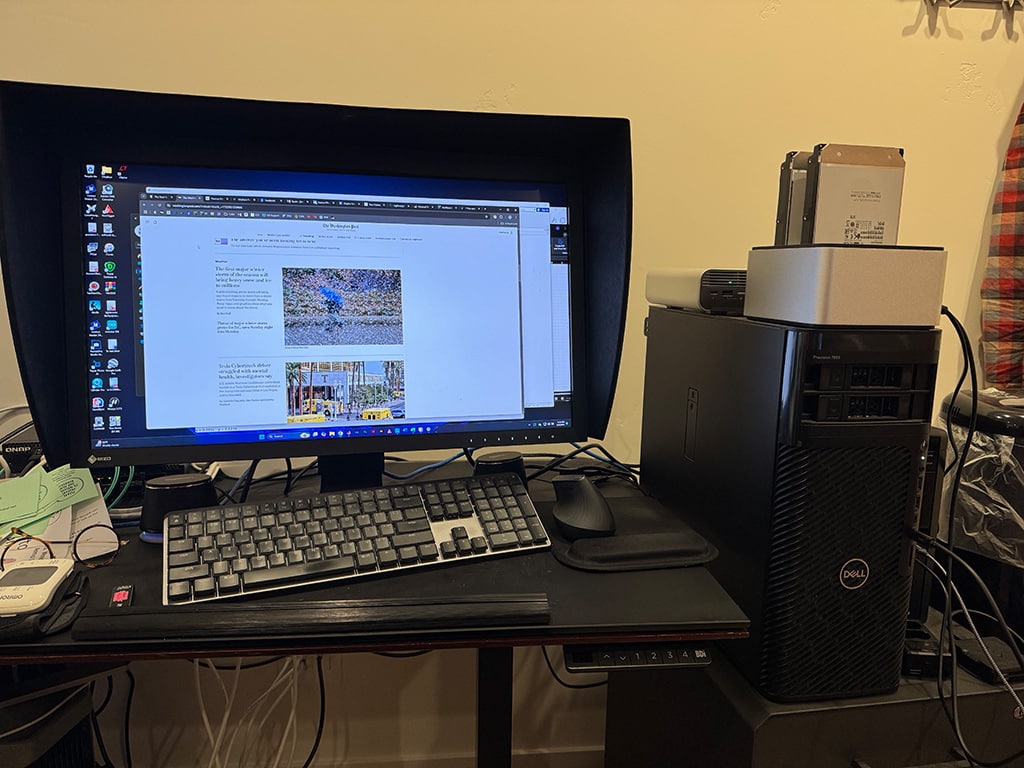

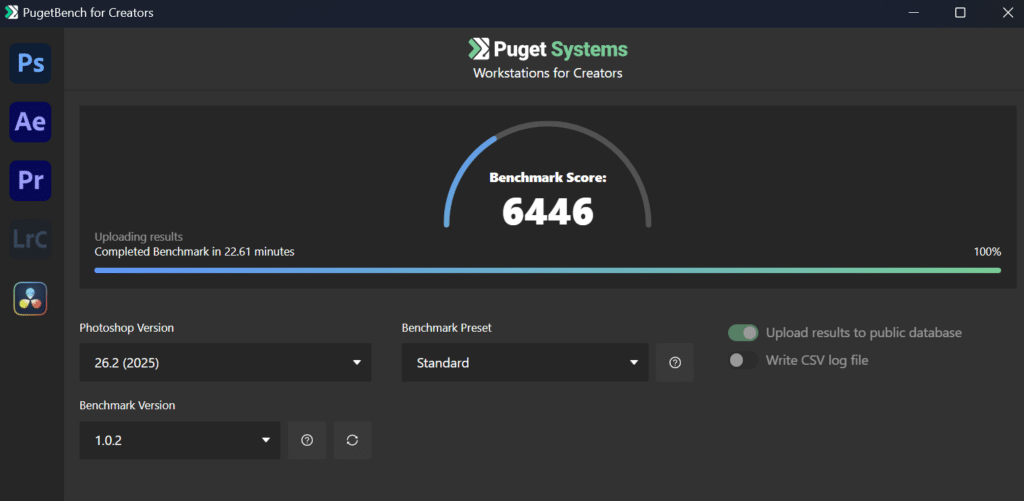

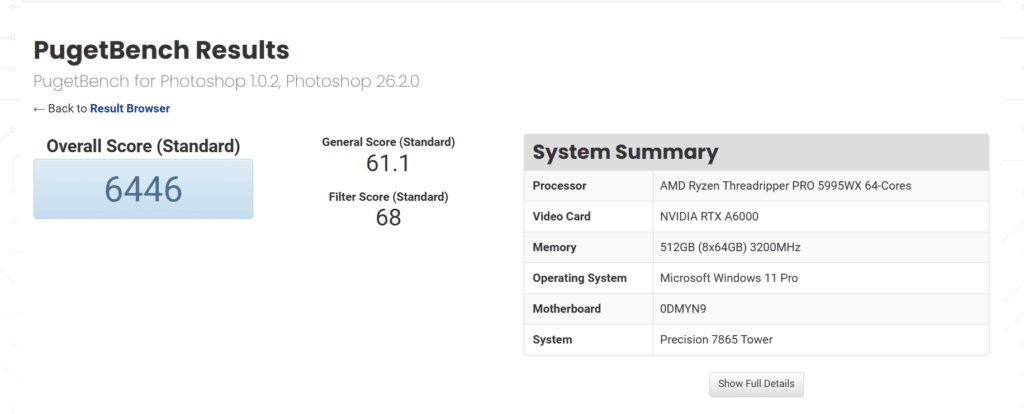
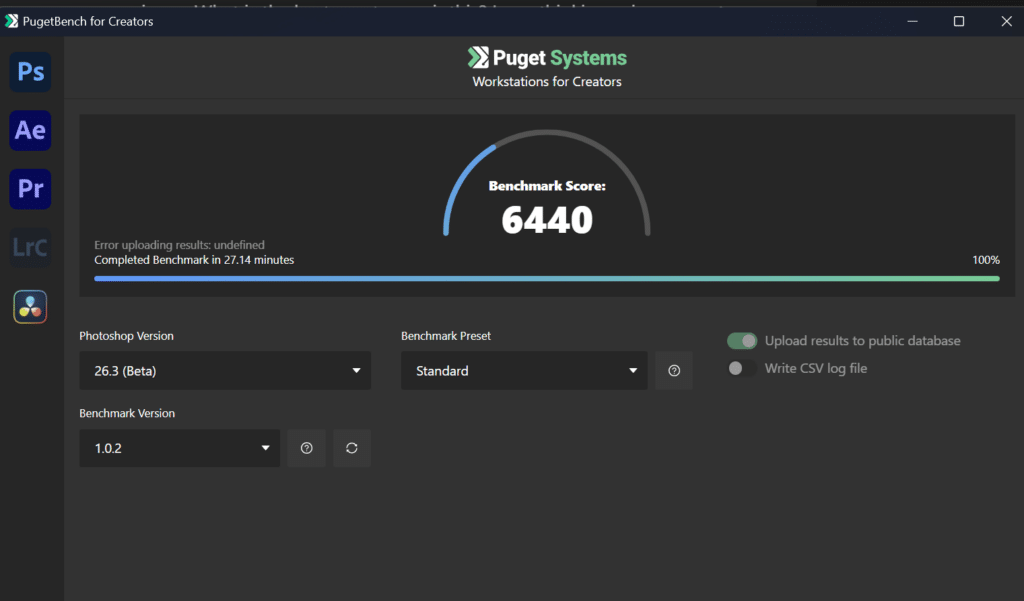
Bryn Forbes says
Thanks for the helpful comparison. Debating between a threadripper and a M4 ultra for my next workstation. Clearly Lightroom and photoshop favors the M4 but also do a bunch of video processing (motion blur, cc wide time, optical flownretiming) in after effects/premiere.
CarVac says
I’m always surprised by how much single-threaded stuff there apparently still is in Photoshop and Lightroom at least on PC.
How much of the speedup is them using Apple’s accelerator APIs that leverage the GPU?
Pieter Kers says
Quite an achievement for a laptop and done with relatively low energy consumption.
I can see on the Puget benchmark rating that it is among the best results.
The larger equally fast but energy consuming Windows Box options remain cheaper as they always have been. About half the price of the Apple laptop.
Less elegant and less mobile.
( I am still on my 7 year old ‘Hackintosh’ ; build in a time Apple refused to make a decent workstation- now 3x slower than this laptop)
Marshall Goldberg says
Pieter, I don’t think you are correct.
Puget publishes benchmark results here:
https://benchmarks.pugetsystems.com/benchmarks/?age=30&benchmark=Photoshop&application=&specs=&page=2#results-table
As you can see, Jim’s Mac crushes the performance of nearly every system tested. I found only one that appears to beat it, by just a few points. That system was:
AMD Ryzen 7 9800X3D 8-Core Processor
NVIDIA GeForce RTX 5090 D
48GB (2x24GB) 8000MHz
The NVIDIA board alone is $2,000 USD, and the AMD processor alone is $500… plus you need a motherboard, RAM, storage and all of that other stuff. Clearly, there is absolutely no way to equal the score of the Macintosh M4 at half its price, and probably not even at the same price… even though Jim’s maxxed-out laptop costs about $4,700 USD.
To be honest, comparing prices of the very fastest and most esoteric equipment isn’t really sane, because the equipment is exotic and priced that way. It makes more sense to drop down to mid-tier systems in the $1,500 to $2,000 range for comparisons. When we do this, however, the pricing differences aren’t very significant. Will a $1,000 Windows machine outperform or equal a $2,000 Mac? Can a $750 PC beat a $1,500 Mac Mini? No, it will not.
Maybe you pay a few hundred dollars more for Mac, but Apple has substantially closed the pricing gap by developing their own CPU.
tag1oner says
The 5090 isn’t relevant to this test. Various computers with a rather huge variance in core counts, cache sizes, and GPUs ranging down to the 4060Ti and 3070 and up to the 5090 have scores within 1% of each other. As the test methodology page says, if you read it, lots of the filters that can run on GPU in photoshop still end up blocked by a CPU thread. Photoshop is pretty terribly multithreaded which is why all the cheap 8-core AMD chips have higher scores than the 16 core and the M4…
There’s an AMD 9700 in there somewhere (~$315 processor with a $260 motherboard, maybe $100 worth of ram, and I’ll call it the balance of $1000 for everything else since it doesn’t matter what GPU they use so might as well use the integrated one if you’re only running photoshop) that beat the M4 Pro by over 2000 points and the M4 Max by over 1000. So yes, virginia, you can do it for under half the price, and by the metric of “crushing” this post uses (6%), you can t-t-t-triple crush the M4 max for under a grand.
The question is, who cares? I’ve been capable of affording apple products for years, and had to develop for them (and linux, and windows, and android, and ios) for 5 years at my last job. I had a free macbook pro that I could take with me when I left and told them I didn’t want the thing. Apple users love the desktop UI, but I’d personally rather put my femur in my hydraulic press and pump the thing down until it snapped than have to use one. The weird part is that it’s just a few minor things that are annoying. The floating elements of the photoshop interface with background programs / desktop in between that are too easy to hit with the mouse if you miss your drag target somewhere and suddenly lose one of the toolbars , and the mighty morphin’ menu at the top are my main things. They don’t even sound that bad to most people. The rest of the problems were all the general instability of OS X when an update would randomly get pushed but I had that same complaint in early Windows 10 when it was basically beta. That’s ignoring the part where Apple’s constant switching of graphics APIs and dropping support for GPUs means lots of Houdini doesn’t work even though it has a native version. When Apple basically starts something like OpenCL, and everyone adds support and it’s basically an industry standard, so you start reworking a major part of a huge complex piece of software to run on GPU via OpenCL, then Apple suddenly pulls support entirely and tells everybody to use Metal when you’re mostly done, it’s not very encouraging in terms of starting up a metal version and having the same code in two languages. Aside from the extra work of doing so, if you do that and then in another 2 years they’re switching to SwiftMetal which needs full rewrites of everything because they decided to make ObjectPascal use Swift string-based-objects to call into an entirely new API that runs on nothing but their GPU, you’re going to lose a LOT of money. You never really lost anything with the OpenCL, because on one side Linux likes open standards and on the other Windows has already supported it for more than 5 minutes which means it will still be usable up until the second the now-red-giant sun finally expands past the planet and cooks off the atmosphere and kills any remaining life. And Apple will absolutely never give you warning (about the software, hardware, or possibly the sun if they decide it’s profitable to get that going early).
Pieter Kers says
Yes Photoshop needs to be optimized for more cores ; they seem not to care at all about that.
Yes,the puget photoshop test does not make much use of the GPU ; and yes Apple makes every year a new OSX and iOS- i !
I would prefer it if they did it every three years so you may have a stable system for about two years… and yes they just make big changes overnight and don’t care about the costumers…
Only if i see the graphic design of Windows- i feel like 1990.
it is so ugly! But then I am a long time Apple user.
John Smith says
Great point about floating Photoshop and the morphing menu. I do editing and when something has to be done at the client’s shop in his Mac using the Apple interface is just slower, and more annoying, than an ergo keyboard on Windows.
John Smith says
Are adults still concerned about a few seconds in processing time for a process? I get that kids who do gaming are, but adults? Do we not just turn to another task for a couple seconds if a process is taking a moment? My windows machine is full of software I need, including a preferable web browser and media player. The Studio display as I understand is not as good as the Eizo, which self calibrates and on that does a Mac do dual displays? Isn’t the floating interface of Photoshop on Apple annoy? Does not some of this have to do with the phone one uses already? Great article, impressive hard work out of Kasson for years.
JimK says
When I was working for IBM I came across a study that indicated that system response times longer than 300 msec lowered productivity.
John Smith says
Of course it does. And in the craft trades and art world, the system is the human, which is why two monitors and an excellent chair beat a faster processor every time.
“If you torture data sufficiently, it will confess to anything.” – Fred Menger